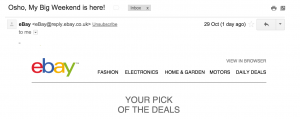Events companies are frequently seen as innovators in the world of social media and digital marketing. Brands often utilise Facebook event pages, digital ticketing and cross-platform promotional tools to enhance their event marketing. In this post I will explore the various ways different events companies utilise the image-based social media platform ‘Instagram’ to emulate the themes, ethos and ideologies of their events.
“One way of reducing the risk the consumer may associate with the purchase… would be through the use of visually-dominated advertising.” (Hirschman, 1986)
There are plenty of guidelines and tips offered to digital marketers looking to utilise Instagram. Customer digital interaction specialists SEEN Digital Media advise brands to use a multitude of techniques to engage and interact with their audiences using Instagram. SEEN offer key digital marketing initiative ideas such as utilising the correct hashtags, following top trends, highlighting user generated content and running engaging contests. Each of these enable brands to enhance their social media presence and effectiveness using Instagram.
Nightclubs and event promotion companies already utilise Instagram to visualise their events, often posting event specific artwork, professional photographs and user generated content. The posts shared by the promotion teams through Instagram build a pictorial representation of a brand, providing a key visual engagement tool to their social media marketing campaigns.
The Warehouse Project in Manchester utilise their Instagram to share professional photographs from their events and to promote event artworks. Personally, I think their Instagram lacks innovation. It represents what they do as an events brand, it’s very industrial and aesthetically pleasing but it could be more engaging. Although they’ve emulated their industrial ethos through the images posted, they don’t utilise user generated content as effectively as they could.
A great example of a company utilising their Instagram page to emulate their ethos is event ticketing company Eventbrite. They share various images from the events hosted on their website, they also provide a behind-the-scenes look into their operations alongside sharing playful images such as a dog in a hat to celebrate #NationalHatDay! – Eventbrite have offered some useful tips to utilise Instagram to promote events, they can be found here.
Playful images clearly are effective promotional tools for events, Instagram can be used to share a multitude of content such as photos, memes, gifs and videos. Competitions are also widely used by events companies to promote specific events. Here’s an example of an effective contest offered by Hospital Records winners of the Drum&Bass Arena award for the “Best Club Night” (for the fourth year running!).
Event planners Todd Events are internationally renowned for their party planning, production and creative skills. They utilise their Instagram to emulate their ethos of world class decor and design, sharing images of elaborate event installations and beautifully orchestrated designs. They boast 22.1k followers on Instagram and the interaction with their images is huge. Their event planning skills are utilised by celebrities who further promote their services through their individual Instagram accounts. Their social reach is vast and extremely effective.
Instagram can be used to promote events in all manor of ways, some much more effectively than others. Generally the visual engagement with a brand is based on the aesthetic value of the images shared. The overall quality of event production can be beautifully emulated through Instagram but be warned; laziness shows, just sharing poster artwork images and a few event images won’t suffice. Brand experience is key, “Brand experience has a positive impact on brand personality and brand personality in turn affects brand reputation” (Vila-López & Rodríguez-Molina, 2013).
The most effective use of Instagram by events brands is through the utilisation of various initiatives and the strict following of guidelines that have been set out by the likes of SEEN and Eventbrite. A strategic approach to Instagram allows brands to truly emulate their ethos using visual marketing techniques. It is imperative for brands to stand out from the crowd, as Thornton Wilder famously said, “In advertising, not to be different is virtual suicide.”
References
Hirschman, E.C., 1986. The effect of verbal and pictorial advertising stimuli on aesthetic, utilitarian and familiarity perceptions. Journal of Advertising,15(2), pp.27-34.
Vila-López, N. and Rodríguez-Molina, M., 2013. Event-brand transfer in an entertainment service: experiential marketing. Industrial Management & Data Systems, 113(5), pp.712-731.
http://blog.seenmoment.com/instagram-marketing-tips-from-the-best-brands
http://www.brainyquote.com/quotes/quotes/t/thorntonwi162984.html#LqAkXlmilosX5MC5.99
http://www.eventbrite.com/blog/ds00-promote-your-event-with-instagram/


